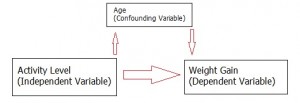Design of Experiments > Confounding Variable
What is a Confounding Variable?
Watch the video for an overview:
A confounding variable is an “extra” variable that you didn’t account for. They can ruin an experiment and give you useless results. They can suggest there is correlation when in fact there isn’t. They can even introduce bias. That’s why it’s important to know what one is, and how to avoid getting them into your experiment in the first place.

In an experiment, the independent variable typically has an effect on your dependent variable. For example, if you are researching whether lack of exercise leads to weight gain, then lack of exercise is your independent variable and weight gain is your dependent variable. Confounding variables are any other variable that also has an effect on your dependent variable. They are like extra independent variables that are having a hidden effect on your dependent variables. Confounding variables can cause two major problems:
Let’s say you test 200 volunteers (100 men and 100 women). You find that lack of exercise leads to weight gain. One problem with your experiment is that is lacks any control variables. For example, the use of placebos, or random assignment to groups. So you really can’t say for sure whether lack of exercise leads to weight gain. One confounding variable is how much people eat. It’s also possible that men eat more than women; this could also make sex a confounding variable. Nothing was mentioned about starting weight, occupation or age either. A poor study design like this could lead to bias. For example, if all of the women in the study were middle-aged, and all of the men were aged 16, age would have a direct effect on weight gain. That makes age a confounding variable.
Confounding Bias
Technically, confounding isn’t a true bias, because bias is usually a result of errors in data collection or measurement. However, one definition of bias is “…the tendency of a statistic to overestimate or underestimate a parameter”, so in this sense, confounding is a type of bias.
Confounding bias is the result of having confounding variables in your model. It has a direction, depending on if it over- or underestimates the effects of your model:
- Positive confounding is when the observed association is biased away from the null. In other words, it overestimates the effect.
- Negative confounding is when the observed association is biased toward the null. In other words, it underestimates the effect.
How to Reduce Confounding Variables
Make sure you identify all of the possible confounding variables in your study. Make a list of everything you can think of and one by one, consider whether those listed items might influence the outcome of your study. Usually, someone has done a similar study before you. So check the academic databases for ideas about what to include on your list. Once you have figured out the variables, use one of the following techniques to reduce the effect of those confounding variables:
- Bias can be eliminated with random samples.
- Introduce control variables to control for confounding variables. For example, you could control for age by only measuring 30 year olds.
- Within subjects designs test the same subjects each time. Anything could happen to the test subject in the “between” period so this doesn’t make for perfect immunity from confounding variables.
- Counterbalancing can be used if you have paired designs. In counterbalancing, half of the group is measured under condition 1 and half is measured under condition 2.
Related Articles:
Age Graded Influences
Confounding by Indication
History Graded Influences
Nonnormative Influences
References
Kotz, S.; et al., eds. (2006), Encyclopedia of Statistical Sciences, Wiley.
Everitt, B. S.; Skrondal, A. (2010), The Cambridge Dictionary of Statistics, Cambridge University Press.
Smith, G. Essential Statistics, Regression, and Econometrics 2nd Edition. Academic Press, 2015.